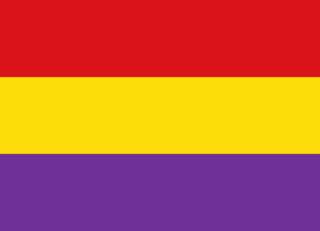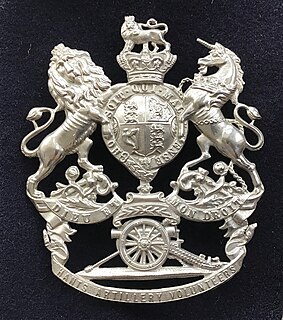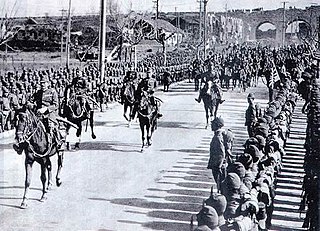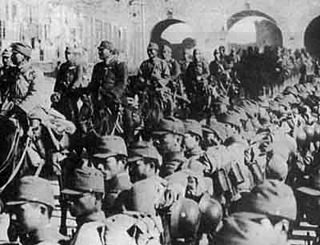 W
WThe 2nd Searchlight Regiment, was an air defence unit of Britain's Royal Artillery formed just before World War II. Deploying to France with the British Expeditionary Force and RAF Advanced Air Striking Force in 1940, it found itself caught up in ground fighting during the Battle of France, including actions at Arras, Boulogne, Calais, and Hondeghem. After the evacuation from Dunkirk it served in home defence in Anti-Aircraft Command until 1944, when it deployed to Europe again, seeing action in the defence of Antwerp and the Scheldt, then the river crossings as 21st Army Group advanced into Germany at the end of the war. It was disbanded in 1948.
 W
WThe Middlesex Yeomanry was a volunteer cavalry regiment of the British Army originally raised in 1797. It saw mounted and dismounted action in the Second Boer War and in World War I at Gallipoli, Salonika and in Palestine, where one of its officers won a Victoria Cross at the Battle of Buqqar Ridge and the regiment rode into Damascus with 'Lawrence of Arabia'. Between the world wars the regiment was converted to the signals role and it provided communications for armoured formations in World War II, including service in minor operations in Iraq, Palestine, Syria and Iran, as well as the Western Desert, Italian and North-West European campaigns. It continued in the postwar Territorial Army and its lineage is maintained today by 31 Signal Squadron, Royal Corps of Signals, which forms part of the Army Reserve.
 W
WThe 6th Battalion, Gloucestershire Regimen, was a Territorial Force unit of the British Army. Originally recruited in Gloucestershire as a Volunteer battalion of the Gloucestershire Regiment during the Second Boer War, it fought on the Western Front and in Italy during World War I. In the late 1930s it was converted into an armoured regiment and served as such during and after World War II
 W
WThe 15th Signal Regiment is military communications unit of the British Army's Royal Corps of Signals.
 W
WThe 20th International Battalion was a battalion of the International Brigades during the Spanish Civil War.
 W
WThe Westminster Dragoons (WDs) was a yeomanry regiment of the British Army Army Reserve, located in central London. Its lineage is continued by one of the Royal Yeomanry's six squadrons. Formed in the aftermath of Second Boer War as part of the County of London Yeomanry, the WDs fought in the Battle of Gallipoli and led British forces onto the beaches during the Normandy Invasion in 1944. The squadron most recently saw action on Operation Telic, for which it was mobilised for the 2003 war in Iraq.
 W
W24th Battalion was a battalion of the London Regiment (1908-1938). Between 1908 and 1938 it was based at the Braganza Street drill hall, though in 1914 it mobilised for war at 71 New Street, Kennington Park Road.
 W
WThe 48th Flying Training Squadron is part of the 14th Flying Training Wing based at Columbus Air Force Base, Mississippi. It operates T-1 Jayhawk aircraft conducting flight training. The squadron is one of the oldest in the Air Force, being formed during World War I as the 48th Aero Squadron on 4 August 1917.
 W
WThe 4th North Midland Brigade, sometimes known as the 'Derbyshire Howitzers', was a part-time unit of Britain's Royal Field Artillery created in 1908 as part of the Territorial Force. It served on the Western Front in World War I. Reorganised between the wars, it was later converted to the anti-aircraft (AA) role. During World War II, part of the regiment served in the Siege of Malta but the rest was captured at the Fall of Tobruk. The reconstituted regiment served on in Anti-Aircraft Command until 1955 and as a unit of the Royal Engineers until 1967.
 W
WThe North Scottish Royal Garrison Artillery and its successors were Scottish part-time coast defence units of the British Army from 1908 to 1961. Although the unit saw no active service, it supplied trained gunners to siege batteries engaged on the Western Front during World War I.
 W
WThe 6th County of London Brigade, Royal Field Artillery was a new unit formed when Britain's Territorial Force was created in 1908. Its origin lay in Artillery Volunteer Corps formed in the Surrey suburbs of South London in the 1860s, which had later been incorporated into a larger London unit. Together with its wartime duplicate it served on the Western Front, at Salonika and in Palestine during World War I. Converted to the anti-tank role just before World War II it saw widely varied service during the war, while its duplicate regiment landed on D-Day. The regiment continued in the postwar Territorial Army until 1961.
 W
WThe 7th London Brigade, Royal Field Artillery was a new unit formed when Britain's Territorial Force was created in 1908. Its origin lay in Artillery Volunteer Corps formed in West London in the 1860s, which had later been incorporated into a larger London unit. Together with its wartime duplicate it served on the Western Front, at Salonika and in Palestine during World War I. It formed several units for service in World War II, when they were in action in North Africa, Italy and North West Europe. The unit continued in the postwar Territorial Army until 1961.
 W
WThe 84th Mixed Brigade, was a mixed brigade of the Spanish Republican Army in the Spanish Civil War. It was formed in March 1937 with battalions of the Iron Column and was disbanded after the tragic events at Mora de Rubielos when 46 soldiers were shot by firing squad in a decimation following the brigade's Battle of Teruel December combats in harsh winter conditions.
 W
WThe 1st Hampshire Artillery Volunteers and its successors were part-time coast defence units of the British Army from 1860 to 1967. Although the units saw no action, they protected the Portsmouth area in both World Wars and supplied trained gunners to siege batteries engaged on the Western Front during World War I. The unit continued in the Territorial Army after World War II.
 W
WThe City of London Yeomanry was a yeomanry regiment of the British Territorial Army, formed in 1901 from veterans of the Second Boer War. In World War I it served dismounted in the Gallipoli Campaign but reverted to the mounted role in the Senussi campaign, at Salonika and in Palestine. It ended the war as a machine gun unit on the Western Front. In the interwar years it was reduced to a battery in a composite Royal Horse Artillery unit in London, but in the period of rearmament before World War II it was expanded into a full regiment of light anti-aircraft artillery. It served in this role during The Blitz and later in the Tunisian and Italian campaigns. Postwar it became an armoured regiment. It amalgamated with the Inns of Court Regiment to form the Inns of Court & City Yeomanry in 1961. The lineage is maintained by 68 Signal Squadron, part of 71 (Yeomanry) Signal Regiment.
 W
WThe Clyde Royal Garrison Artillery and its successors were Scottish part-time coast defence units of the British Army from 1910 to 1967. Although they unit saw no active service, they supplied trained gunners to siege batteries engaged on the Western Front during World War I.
 W
WThe Dimitrov Battalion was part of the International Brigades during the Spanish Civil War. It was the 18th battalion formed, and was named after Georgi Dimitrov, a Bulgarian communist and General Secretary of the Comintern in that period.
 W
WThe Forth Royal Garrison Artillery and its successors were Scottish part-time coast defence units of the British Army from 1908 to 1956. Although they saw no active service, they supplied trained gunners to siege batteries engaged on the Western Front during World War I.
 W
WThe 1st Hampshire Artillery Volunteers and its successors were part-time coast defence units of the British Army from 1860 to 1967. Although the units saw no action, they protected the Portsmouth area in both World Wars and supplied trained gunners to siege batteries engaged on the Western Front during World War I. The unit continued in the Territorial Army after World War II.
 W
WIndependent Operational Group Silesia was an Operational Group of the Polish Army, created in September 1938 to annex Zaolzie from Czechoslovakia.
 W
WThe International Brigades were military units set up by the Communist International to assist the Popular Front government of the Second Spanish Republic during the Spanish Civil War. The organization existed for two years, from 1936 until 1938. It is estimated that during the entire war, between 40,000 and 59,000 members served in the International Brigades, including 15,000 who died in combat.
 W
WJagdgeschwader 134 "Horst Wessel" was a Luftwaffe fighter-wing prior to World War II. JG 134 was formed on 4 January 1936 with III. Gruppe in Döberitz. The Geschwader was given the honorific name Horst Wessel on 24 March 1936. II Gruppe was formed on 15 March 1936 in Werl and was followed by the Geschwaderstab and I. Gruppe on 1 April 1936 in Dortmund. It would later become one of the premier Zerstörer wings of the Luftwaffe, as Zerstörergeschwader 26.
 W
WThe Japanese Central China Area Army was a field army of the Imperial Japanese Army during the Second Sino-Japanese War.
 W
WThe 1st Lancashire Artillery Volunteers, popularly known as 'Brown's Corps', was an auxiliary unit of the British Army raised in Liverpool in 1859. As the Lancashire & Cheshire Royal Garrison Artillery in the Territorial Force it was responsible for defending the Mersey Estuary and the coastline of North West England. It was one of the few coast defence units to fire a shot during World War I but also provided personnel for a number of siege batteries that saw action on the Western Front. It continued in the coast defence role during World War II, at the end of which it sent troops to work in the rear areas in Europe. It was reformed postwar but was broken up when the coast artillery branch was abolished in 1956.
 W
WThe Lincoln Battalion was the 17th battalion of the XV International Brigade, a mixed brigade of the International Brigades also known as Abraham Lincoln Brigade. It was organized by the Communist International with great care to conceal or minimize the communist character of the enterprise. Attractive names were deliberately chosen for the International Brigades, such as "Garibaldi" in Italy or "Abraham Lincoln" in the United States.
 W
WThe Mackenzie–Papineau Battalion or Mac-Paps were a battalion of Canadians who fought as part of the XV International Brigade on the Republican side in the Spanish Civil War in the late 1930s. Except for France, no other country had a greater proportion of its population volunteer in Spain as did Canada. The XV International Brigade, made up also of volunteer battalions from the United States and Britain, was involved in the Battle of Jarama, in which nine Canadians are known to have been killed.
 W
WThe Pembroke Royal Garrison Artillery was a part-time unit of the British Army that defended the coast of West Wales during both world wars. Although it never saw action in its coastal defence role, it manned a number of siege batteries of heavy howitzers for service on the Western Front and Italian Front in World War I.
 W
WThe Shanghai Expeditionary Army was a corps-level ad hoc Japanese army in the Second Sino-Japanese War.
 W
WThe Japanese 10th Army was an army of the Imperial Japanese Army during the Second Sino-Japanese War.
 W
WThe Thames and Medway Coast Artillery, which at its peak comprised three full regiments, was formed in Britain's Territorial Army in 1932 to man coastal defence guns on both banks of the Thames Estuary. It served in this role during World War II, at the end of which it sent troops to work in the rear areas in Europe. It was reformed postwar but was broken up when the coast artillery branch was abolished in 1956.
 W
WThe Ukrainian interbrigade company Taras Shevchenko was a Ukrainian formation, which participated in the Spanish Civil War on the Republican side. It was composed of the Ukrainian citizens of Poland, who were members of the Communist Party of Western Ukraine.
 W
WThe Yugoslav volunteers in the Spanish Civil War, known as Spanish fighters and Yugoslav brigadistas, was a contingent of volunteers from the Kingdom of Yugoslavia that fought for the Republicana during the Spanish Civil War (1936–1939). An estimated 1,664 "Yugoslav brigadistas" fought in the war, out of whom c. 800 were killed in action. According to Spanish statistics, 148 Yugoslav volunteers received the officer rank during the conflict.